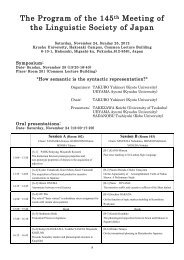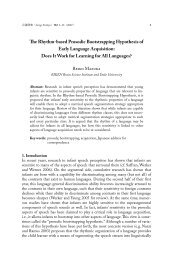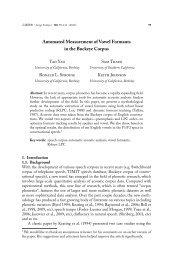第117åæ¥æ¬è§£åå¦ä¼ç·ä¼ã»å ¨å½å¦è¡éä¼ è¬æ¼ããã°ã©ã ã»æé²é PDF ...
第117åæ¥æ¬è§£åå¦ä¼ç·ä¼ã»å ¨å½å¦è¡éä¼ è¬æ¼ããã°ã©ã ã»æé²é PDF ...
第117åæ¥æ¬è§£åå¦ä¼ç·ä¼ã»å ¨å½å¦è¡éä¼ è¬æ¼ããã°ã©ã ã»æé²é PDF ...
Create successful ePaper yourself
Turn your PDF publications into a flip-book with our unique Google optimized e-Paper software.
104<br />
117 <br />
OIPM<br />
EDA <br />
<br />
<br />
<br />
<br />
<br />
TGFβ1 <br />
<br />
TGFβ1 <br />
TGFβ1 24 <br />
FN EDA 48 α<br />
αSMA<br />
<br />
EDA 48 <br />
αSMA <br />
TGFβ1 <br />
FN EDA TGFβ1 <br />
<br />
EDA <br />
<br />
OIPM<br />
Fertilization analyzed by live imaging in the mouse<br />
Kiyotaka Toshimori, Chizuru Ito, Kenji Yamatoya, Mamiko Maekawa,<br />
Yoshiro Toyama<br />
Dept. Anatomy and Developmental Biology, Grad. Sch. Med., Univ. Chiba<br />
In order to analyze the fertilization process, it is important to visualize the events<br />
continuously induced during spermegg interaction. We analyzed the fertilization<br />
process by live imaging in the mouse, focusing on the relationship between<br />
pronucleus formation and fate of inner acrosomal membrane protein Equatorin<br />
EQT.<br />
Eggs interacting with fertilizing sperm in vivo were removed from oviduct<br />
and analyzed by live images, including immunofluorescence microscopy with<br />
antibodies against various sperm components and EQTEGFPtransgenic mice,<br />
under Olympus IX71 microscope equipped with high resolution Roper and<br />
CSU razor system Yokogawa. Sperm head was internalized and completely<br />
decondensed, releasing EQT in the ooplasm; it was before the initiation of<br />
the tail entry. Female pronucleus formation, in which a second polar body is<br />
released into the perivitelline space, started a bit faster than the male pronucleus<br />
formation, which was induced in the fertilization cone. It took about 90min to<br />
start the fertilization cone formation after spermegg fusion. Other live images<br />
and corresponding structural changes at early spermegg interaction stage will be<br />
presented.<br />
OIPM<br />
<br />
<br />
1 3 1,2 1 1 <br />
1 1,2<br />
1<br />
2 3 Dept. Pharmacology,<br />
Physiology and Toxicology, Marshall Univ. Joan C. Edwards School of Med. USA<br />
DecaBDE<br />
DecaBDE <br />
<br />
<br />
<br />
DecaBDE <br />
DecaBDE <br />
<br />
CTTN ERK 1/2SRC <br />
DecaBDE <br />
DecaBDE <br />
ICR 1-5 <br />
12 <br />
<br />
<br />
DecaBDE <br />
<br />
OIPM<br />
microRNA <br />
<br />
1 1 2 3 4 3 <br />
2 3<br />
1<br />
2 3 <br />
4<br />
<br />
microRNAmiRNA <br />
PE miRNA <br />
<br />
PE <br />
RNA GAIIx TaqManq<br />
Array in silico <br />
laser microdissection [LMD]realtime PCRWestern<br />
blot BeWo miRNA <br />
3’UTR<br />
1,000 <br />
667 PE 22 <br />
PE miRNA In silico 5 PE miRNA<br />
<br />
HSD17B1 PE HSD17B1 <br />
mRNA <br />
PE miRNA miR210 miR518c <br />
LMD miRNA <br />
<br />
miR210 miR518c HSD17B1 <br />
PE miRNA <br />
<br />
OEAMIII<br />
<br />
<br />
<br />
C3<br />
<br />
<br />
Lenhossék <br />
86, p9, 2011<br />
<br />
<br />
C1, 2 <br />
Isl1 <br />
Nkx2.2 <br />
C3 Lenhossék <br />
<br />
2 <br />
Phox2b <br />
<br />
<br />
<br />
<br />
OEAMIII<br />
NPY <br />
<br />
<br />
Y<br />
NPY NPY <br />
<br />
NPY<br />
<br />
<br />
NPY <br />
NPY <br />
80% NOS NPY <br />
40% 90% <br />
NOS NPY <br />
NOS TH <br />
NPY NOS ChAT<br />
NPY TH <br />
NPY <br />
ChAT/NPY NOS/NPY <br />
NOS/NPY







